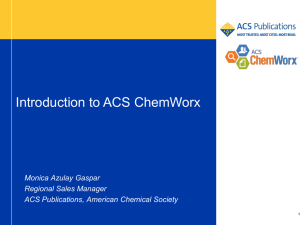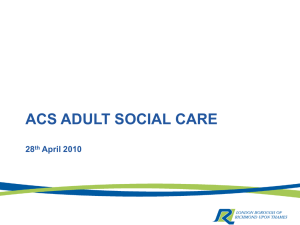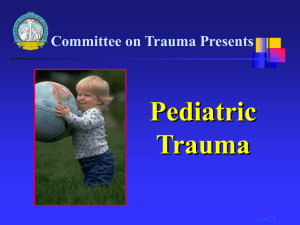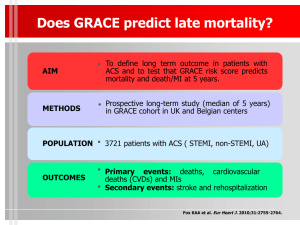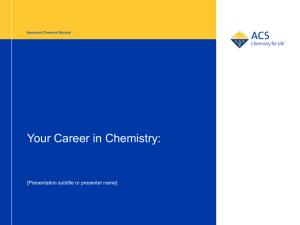βE rac
advertisement
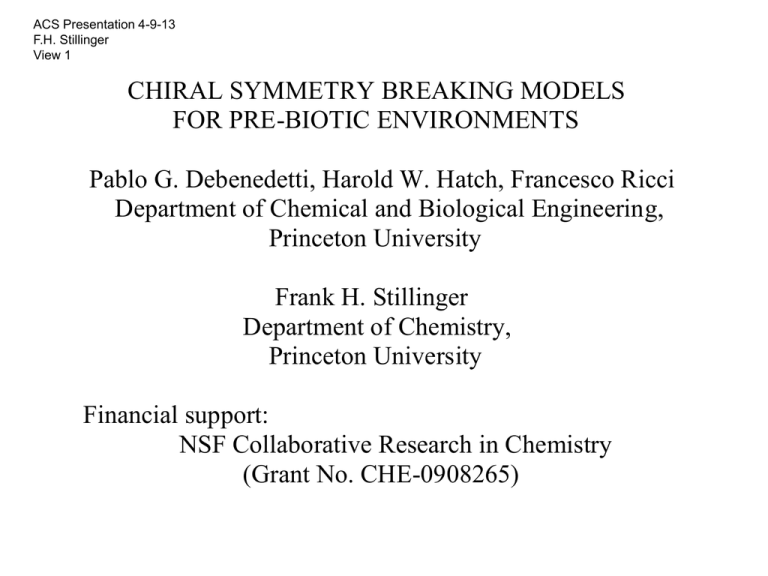
ACS Presentation 4-9-13 F.H. Stillinger View 1 CHIRAL SYMMETRY BREAKING MODELS FOR PRE-BIOTIC ENVIRONMENTS Pablo G. Debenedetti, Harold W. Hatch, Francesco Ricci Department of Chemical and Biological Engineering, Princeton University Frank H. Stillinger Department of Chemistry, Princeton University Financial support: NSF Collaborative Research in Chemistry (Grant No. CHE-0908265) ACS Presentation 4-9-13 F.H. Stillinger View 2 ACS Presentation 4-9-13 F.H. Stillinger View 3 SOME RELEVANT PUBLICATIONS: Homogeneous Solution Lattice Model [E = experiment, T = theory] 1. F.C. Frank, "On Spontaneous Asymmetric Synthesis", Biochim. Biophys. Acta, 11, 459-463 (1953). [T] 2. K. Soai, T. Shibata, H. Morioka, and K. Choji, "Asymmetric Autocatalysis and Amplification of Enantiomeric Excess of a Chiral Molecule", Nature 378, 767-768 (1995). [E] 3. D. Blackmond, C.R. McMillan, S. Ramdeehul, A. Schorm, and J.M. Brown, "Origin of Asymmetric Amplification in Autocatalytic Alkylzinc Additions", J. Am. Chem. Soc. 123, 10103-10104 (2001). [E] 4. H.W. Hatch, F.H. Stillinger, and P.G. Debenedetti, "Chiral Symmetry Breaking in a Microscopic Model with Asymmetric Autocatalysis and Inhibition", J. Chem. Phys. 133, 224502 (2010). [T] 5. F. Ricci, F.H. Stillinger, and P.G. Debenedetti, "Creation and Persistence of Chiral Asymmetry in a Microscopically Reversible Molecular Model", J. Phys. Chem. B 117, 602-614 (2013). [T] ACS Presentation 4-9-13 F.H. Stillinger View 4 ACS Presentation 4-9-13 F.H. Stillinger View 5 ACS Presentation 4-9-13 F.H. Stillinger View 6 ACS Presentation 4-9-13 F.H. Stillinger View 7 ACS Presentation 4-9-13 F.H. Stillinger View 8 ENANTIOMERIC EXCESS "ee" Number of enantiomers present at time t: N R (t ) , N S (t ) Definition: ee ( t ) Obvious limits: Racemic system: N R (t ) N S (t ) N R (t ) N S (t ) 1 ee (t ) 1 ee 0 Scalemic system: | ee | 0 Enantiopure system: | ee | 1 Indicator of chiral symmetry breaking for an ensemble of macroscopically equivalent systems is bimodality of the ee probability distribution Q (ee ) . ACS Presentation 4-9-13 F.H. Stillinger View 9 ACS Presentation 4-9-13 F.H. Stillinger View 10 ACS Presentation 4-9-13 F.H. Stillinger View 11 ACS Presentation 4-9-13 F.H. Stillinger View 12 PARAMETER ESTIMATES TO PRODUCE GEOLOGICAL TIME SCALE EE PERSISTENCE 3 System size V = (1 meter) ; ambient T and p Initial reactant concentration at beginning of monomer purification stage: [ A] [B 2 ] 10 5 M Reverse reactions form free reactants, these combine without catalysis to form minor enantiomers, which then are sequestered in long-lived heterodimers. Racemization is effectively controlled by binary kinetics: ( d / dt )[ A] k [ A] 2 Choose a representative second order rate constant: k 4 . 83 10 36 3 m /s Implied half life of chiral persistence: 6 t1 / 2 1 /( k [ A] in ) 10 yr 1 meter diffusion time, serine in water: 5 yr ACS Presentation 4-9-13 F.H. Stillinger View 13 OSTWALD RIPENING PHENOMENON (W. Ostwald, 1896) Standard application refers to a size distribution of crystals composed of a single species. These are suspended in a solvent that is close to saturation in that species. Due to higher surface/volume ratio, smaller crystals are more soluble than larger crystals. Molecules preferentially leave small crystals, diffuse through the solvent, and add to larger crystals. Eventually only a single large crystal will remain, in contact with a solution whose near-saturation concentration is determined by that crystal's size. ACS Presentation 4-9-13 F.H. Stillinger View 14 ACS Presentation 4-9-13 F.H. Stillinger View 15 SOME RELEVANT PUBLICATIONS: Model for Three-Phase Slurry with Stirring [E = experiment, T = theory] 1. C. Viedma, "Chiral Symmetry Breaking During Crystallization: Complete Chiral Purity Induced by Nonlinear Autocatalysis and Recycling", Phys. Rev. Letters 94, 065504 (2005). [E] 2. W.L. Noorduin, H. Meekes, A.A.C. Bode, W.J.P. van Enckevort, B. Kaptein, R.M. Kellogg, and E. Vlieg, "Explanation for the Emergence of a Single Chiral Solid State during Attrition-Enhanced Ostwald Ripening: Survival of the Fittest", Cryst. Growth Des. 8, 1675-1681 (2008). [T] 3. W.L. Noorduin, W.J.P. van Enckevort, H. Meekes, B. Kaptein, R.M. Kellogg, J.C. Tully, J.M. McBride, and E. Vlieg, "The Driving Mechanism Behind Attrition-Enhanced Deracemization", Angew. Chemie 122, 8613-8616 (2010). [E,T] 4. J.E. Hein, B.H. Cao, C. Viedma, R.M. Kellogg, and D.G. Blackmond, "Pasteur's Tweezers Revisited: On the Mechanism of AttritionEnhanced Deracemization and Resolution of Chiral Conglomerate Solids", J. Am. Chem. Soc. 134, 12629-12636 (2012). [E] 5. H. Katsuno and M. Uwaha, "Appearance of a Homochiral State of Crystals Induced by Random Fluctuation in Grinding", Phys. Rev. E 86, 051608 (2012). [T] ACS Presentation 4-9-13 STIRRED THREE-PHASE SLURRY MODEL: F.H. Stillinger CHIRAL SYMMETRY BREAKING DUE TO ATTRITION-ENHANCED View 16 OSTWALD RIPENING Fixed total number N of R and S enantiomers: N N R (t ) N S (t ) Enantiomers present as monomers in liquid solution, and as enantiopure crystals containing 2 m i N molecules ( i R , S ). Solvent property: Monomer numbers chosen for saturated liquid Reversible rate processes: (1) Liquid phase racemization of R and S monomers: p rac exp( E rac ) . (2) Crystal growth or dissolution (gain/loss of monomer from/to solution): d / dt m i [ i ( m i ) pg , 2/3 K (mi ) 1 / 3 ] i = supersaturation ratio for i R or S . Irreversible rate processes, stirring-rate-determined: (3) Crystal attrition (random binary fracture for m 4 ) by input of mechanical energy : p attr . (4) Crystal agglomeration (dimer addition, m 2 ): (2) p agglom p g X i , (2) Xi = dimer fraction of i crystals. ACS Presentation 4-9-13 F.H. Stillinger View 17 CHIRAL MOLECULE INVENTORY Fixed total inventory: N N R ( t ) N S ( t ) , (m ) N R ( t ) mn R (m ) N S ( t ) mn S (t ) , m 1 (t ) . m 1 (1) At time t 0 the liquid solution contains n R ( t ) monomers of type R, and n S(1) ( t ) monomers of type S: (1) L (1) (1) (1) ee ( t ) [ n R ( t ) n S ( t )] /[ n R ( t ) n S ( t )] (m ) . (m ) The crystal slurry at time t 0 consists of n R ( t ) and n S ( t ) enantiopure crystals containing m 2 R or S molecules, respectively: ee C (m ) (t ) m[n R m2 (m ) (t ) n S ( t )] (m ) (m ) ( t )] m[n R (t ) n S m2 L Initial conditions: R and S saturated liquid with ee ( 0 ) 0 , ee C ( 0 ) 0 (racemic or slightly biased); Gaussian distributions of R and S crystals wrt. m 2 . Typical range of total number of molecules used in Monte Carlo simulations: 40 , 000 N 200 , 000 ACS Presentation 4-9-13 F.H. Stillinger View 18 ACS Presentation 4-9-13 F.H. Stillinger View 19 With agglomeration βErac = 5, pattr = 0.4, K = 1, eeC0 = 0.055, Ntotal = 206660, Neq = 10000, NL0 = 10000 ACS Presentation 4-9-13 F.H. Stillinger View 20 With agglomeration βErac = 5, pattr = varying, K = 1, eeC0 = 0.055, Ntotal = 206660, Neq = 10000, NL0 = 10000 ACS Presentation 49-13 F.H. Stillinger View 21 With agglomeration βErac = 5, pattr = varying, K = 1, eeC0 = 0.055, Ntotal = 206660, Neq = 10000, NL0 = 10000 ACS Presentation 4-9-13 F.H. Stillinger View 22

